A Long Overdue Review
Vietnam: 1965-1975 is a board game based simulation of the entire American conventional military intervention in Vietnam from 1965, when the first regular ground formations were committed, to the ultimate victory of the North Vietnamese Army at the fall of South Vietnamese capital city of Saigon in 1975.
It is a two-player game, but can easily be expanded to four players: American, South Vietnamese, North Vietnamese, Viet Cong. There’s enough going on to keep four players quite busy. The American and South Vietnamese forces compete with North Vietnamese and Viet Cong adversaries for control over the civilian population of South Vietnam. The combatants are:
- United States – The US Army, Marine Corps, Air Force and Navy
- South Vietnam – The Army of the Republic of Vietnam (ARVN) – Fights along side the U.S.
- North Vietnamese Army – North Vietnamese Army (NVA)
- Viet Cong – (VC) Guerilla forces in the south controlled by North Vietnam
The NVA and VC are collectively referred to as the “National Liberation Front” (NLF) and the US and ARVN are referred to as “Allied” forces. In addition, the game has additional units collectively referred to as “Free World Allies” that represent the other nations that committed troops to support the US war effort (i.e. Korean, Australian, Thai, etc.).
The game map covers the entire geographic area of South Vietnam, a small strip of North Vietnam just north of the South Vietnamese border, and portions of Laos and Cambodia that share a border with Vietnam.

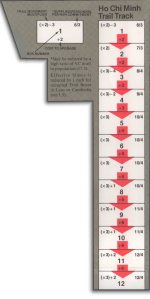
The “Ho Chi Minh Trail”, described as a complex network of truck routes, foot and bicycle paths, and river transportation systems used for transporting supplies from North Vietnam to fighting units in the south, is featured prominently in this game. It is represented by a physical section of the map, designated as the Trail, which runs the length of South Vietnam, and by the “Trail Track” which regulates the rate of movement for NLF units along the track as well as the efficiency with which supplies are moved down the trail. Movement, combat, and interdiction of the Trail will significantly affect outcomes on the battlefield. Game rules forbid the US/ARVN player from invading North Vietnam, but Laos and Cambodia are both fair game although the political consequences of such invasions can be harsh, as is the Ho Chi Minh Trail itself.
The game is a “monster” (in war gamer parlance) because:
- It’s a physically large game, played on two 22″x34″ maps, and requires a large table to set up.
- The time commitment required to play a full Campaign Game, which covers the entire 10 year conflict, requires 100 to 200 hours of actual play time!
- It covers strategic decisions such as management of American troop levels, invasion of bordering sovereign countries, etc., as well as operational command decisions. So there’s a considerable amount of information to keep track of.
There are several smaller scenarios that allow for a shorter game (although, with two exceptions, none of them are really “short”). They focus almost exlcusively on the combat aspects of the game, ignoring the strategic/political aspects. Most of the discussion in this article of strategic, political and/or grand operational considerations apply to the grand campaign scenario. Note, however, that that management of combat operations is identical for any of the scenarios (i.e. in the campaign game, you get to decide which American units are deployed to Vietnam but, in any of the scenarios, you’ll decide how they’ll perform combat operations).
Each player may command well over 100 units, planning and executing Search & Destroy, Clear & Secure, Security, Bombardment, Patrol, Hold and Strategic Movement operations with the objective of not just winning battles, but of swaying the population in their direction. Each of the 35 provinces (plus the special Saigon/Gia Dinh area) are worth a certain number of Population points. By keeping a province clear of NLF units, the US/ARVN player may gradually gain control of more of the province’s population. The NLF player can win the game by either controlling 200 or more total population points or by capturing Saigon. The US player wins by just preventing either of these occurrences until the end of Spring 1975.
For those who are up to the challenge, Vietnam: 1965-1975 can be quite a rewarding gaming experience. However, those who require a bit of “blitzkrieg” in every war game they play will likely find themselves in therapy before too long. Vietnam is one of those games that you either love or hate. Personally, I’m in the “love” camp, but I can understand the opposing viewpoint.
When judging games by how well they capture the “feel” of the conflict they represent, this game has no equal. But that’s not necessarily a good thing! The Vietnam War, as described in every book I’ve ever read and as described by every veteran I’ve ever spoken to, was a grind. The game is no different. The frustration level for both players registers quite high. When applying standard tactics reminscent of the period, the U.S. player wins battle after battle and yet the Vietnamese population continues to drift toward NLF control. The NLF player tries to take solace in the fact that, by gradually winning control of the population, he’s winning the game, but it’s hard to stay upbeat while suffering one crushing military defeat after another. Clearly a new U.S. stragegy is required in order to prevent the historical outcome. But what, exactly, should that strategy be? Once it becomes apparent that the U.S. is not following the historical script, will the NLF player be able to formulate an effective counter-strategy?
How the Game Works
The game is played over a maximum of 10 Years (game years, that is, but it can sometimes feel like 10 real years). Each Year is divided into 4 Seasons, and each Season is further divided into 2 Game Turns. The Game Turn is the basic operational unit of time. All combat operations take place during the Game Turn. The Season is the basic strategic unit of time. All strategic/political decisions are made during the “Seasonal Interphase”. During the Spring Season U.S. Air and Airmobile points are reduced by 25% (due to the onset of monsoon season) but, other than that, all Seasons are identical.
How the U.S. Works
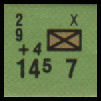
U.S. involvement in Vietnam is tracked via two measures: Commitment and Morale. Everything the U.S. player commits to the war (troops, air power, military aid to South Vietnam, etc.) will raise the U.S. Commitment Level by a fixed amount, according to costs listed on the US Unit Chart. For example, a combat battalion costs 1 Commitment point, and Air points can be purchased in groups of 3 for 1 Commitment point. Morale is an abstract measure that can be described as the U.S. public’s willingness to continue the war. Morale can go up or down, generally depending on the current level of U.S. involvement and U.S. success on the battlefield (see the Morale Charts for more detail about what makes Morale go up or down). But the trend is generally downward, as there are many more items that will lower Morale than raise it. The game begins with the U.S. Commitment Level at 25 and Morale at 520. Morale must always remain higher than Commitment. If Commitment goes higher than Morale, the U.S. player must reduce his Commitment to bring the level down below the Morale level (i.e. withdraw).
Thus usually begins the downward spiral of withdrawal and defeat for the U.S.
If the U.S. war effort has been managed well, the withdrawing U.S. military should leave a formidable ARVN force behind. Also, since the U.S. is never forced to completely withdraw Air power, a serious amount of support can be left behind to support ARVN operations. The ARVN in this game, as they were in real life, are quite capable of defending themselves against the NVA… as long as they retain the ability to replace their losses.
How the ARVN Works
The ARVN is composed of South Vietnamese people, under government control, matched up with U.S. provided equipment. As long as the Allies control sufficient South Vietnamese population to draft into the South Vietnamese Army, and the U.S. can afford to continue to convert U.S. Commitment into South Vietnamese military supplies, the ARVN should be able to withstand the NLF assaults.
U.S. Commitment points are converted to ARVN military supplies at a rate of 1 to 7 (i.e. 7 SVN Supplies for 1 US Commitment), at the U.S. player’s discretion. The South Vietnamese can then use the military supplies, and population subject to the draft, to purchase combat units, replacement points, etc., according to the costs listed on the ARVN Unit Chart.

What’s unique about the ARVN situation is that each combat unit on the map is under the command of an ARVN military leader. Divisions are commanded by 1-Star Generals, Corps are commanded by 2-Star Generals. A divisional combat unit is directly subordinate to its Division Commander and then to the Division’s Corp Commander. Any unit that is not directly subordinate to a division will fall under the direct command of one of the Corps Commanders or, in the case of ARVN non-divisional units, directly under the Chief of Staff. These leaders are represented by actual counters and serve two functions:
- Two-Star leaders are used to determine if their will be a Coup attempt during any Seasonal Interphase.
- One- and Two-Star leaders are rated each Season as either effective or ineffective.
An “ineffective” ARVN leader causes the units under his command to be ineffective as well, which essentially renders them incapable of conducting useful military operations. Too many ineffective ARVN divisions will force the brunt of the fighting and dying to be shifted to the U.S. player, which will likely result in reduced U.S. Morale and increased U.S. Commitment, thus hastening the day when U.S. forces must withdraw.
Three-Star leaders represent high government officials (President, etc.). There is always exactly one 3-Star leader in play at any given moment. These leaders are subject to Coups based on the loyalty of the 2-Star leaders. Coups keep things off balance thus causing instability in the ARVN Officer Corps (frequent replacing of division and corps commanders, etc.) which ends up creating more ineffective ARVN units. This can become a vicious cycle which can really bog down the U.S./ARVN war effort.
South Vietnam also has a Morale level that is weighed down by events such as Coups , loss of population control, and battlefield failure (loss of provincial capitals) but can be boosted by U.S. Economic Aid (bought with U.S. Commitment points), and U.S. bombing of North Vietnam. It also will increase in proportion to new U.S. Commitment spent, for any reason such as troops, air power, or naval units. Note that there is no South Vietnamese “commitment” level. As the rule book says, “South Vietnam is the conflict; it cannot chose to increase or decrease its involvement.”
How the NVA Works
The North Vietnamese Army uses the same basic measures of Commitment and Morale as the U.S. player, except that NVA Morale represents the willingness of China and the USSR to provide the material support required to continue the fight. Every time U.S. increases Commitment, NVA Morale automatically increases proportionally. So, exactly opposite from the U.S. player, the trend of NVA Morale is generally upward. As NVA Morale increases, the NLF can spend additional Commitment points as well. The basic rules are the same, however, so the NVA player must always adhere to the rule that its Morale must always be higher than its Commitment. If this rule is ever violated the NVA must reduce Commitment to at, or below, current Morale (although this is a rare occurrence).
NVA Commitment can be used to purchase NVA units, improve the efficiency of the Ho Chi Minh Trail, and furnish military supplies to the Viet Cong. See the NVA/VC Unit Charts. NVA units are conventional combat units, similar in most respects to U.S. and ARVN combat units. The Viet Cong, however, form the backbone of the NLF’s insurgency in the South, at least until the later stages of the war.
How the Viet Cong Works
The Viet Cong are composed of South Vietnamese people, under VC control, combined with North Vietnamese provided military supplies. They are in direct competition with the ARVN for a finite amount of South Vietnamese people subject to military conscription. NVA Commitment points are converted to Viet Cong supplies at a variable rate. NVA Commitment can be sent south via the Ho Chi Minh Trail (Trail Supply) or via coastal craft (Sea Supply). The actual conversion rate to VC supply will depend on the U.S. naval interdiction level, the current condition of the Ho Chi Minh trail, and the U.S. effort to interdict the Trail.
The VC have the unique advantage of hidden deployment. The exact strength of any VC unit is not known until an allied player’s unit occupies the same hex or launches an attack on the unit from an adjacent hex. They also have an Alert capability which allows them to react and potentially escape from allied attacks. The VC also have the unique ability to disperse rather than face combat, increasing their replacement pool by the strength of the dispersing unit. For example, if a 2-strength VC unit is forced into combat by a U.S. battalion, the VC unit can opt to simply “disperse”, increase the VC replacement pool by 2, and force the U.S. unit to immediately end it’s operations for the Game Turn.
The VC also have units called Political Sections which are essentially dummy units, and are quite useful in drawing U.S. units into fruitless Search & Destroy operations. The majority of VC units are battalion sized or smaller, but the U.S. player should not be lulled into thinking that he’ll always be dealing with weak VC forces. If left unchecked, powerful VC regiments can be formed, complete with HQ units and supporting artillery. The VC will bear the brunt of the fighting, at least for the first few years of the war, and are quite capable of doing so.
Pacification
The most fundamental concept in Vietnam: 1965-1975 is Pacification. It is the key to victory for both players. Unless the NLF player can somehow take down Saigon without controlling a significant percentage of the population, which is possible but not very likely.
The game map delineates 35 South Vietnamese provinces, plus the special Saigon/Gia Dinh area. Each province has a population value (for game purposes) ranging from 4 to 15. The game rules state that this is roughly 50,000 people per 1 population point. A province’s population is usually divided between US/ARVN and NLF control. There is a Pacification Control Sheet that is used to keep a running record of population control.
The seasonal Pacification procedure rewards the US/ARVN player for keeping provinces free of NLF units. The NLF are rewarded for having units present in a province; the more valuable the real estate, the better. For example, if there are several VC units in a provincial capital town, the NLF pacification benefit will be much greater than if they just had several units in a remote mountain hex.
Once a significant percentage of a province’s population falls under the control of one side or the other, it’s quite difficult to reverse the trend, so much operational decision making revolves around a province’s pacifcation status.
Combat Operations
I won’t go into a tremendous amount of detail regarding combat operations as I’m preparing another article on that subject, but I will provide a brief outline to give a general sense of how combat operations proceed during a Game Turn.
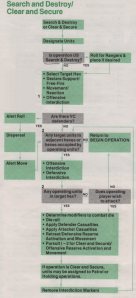
Combat operations in Vietnam: 1965-1975 are representative of operations conducted in the war. The standard operation is a Search & Destroy, but other operations include Clear & Secure, Bombardment, Patrol, Hold, Strategic Movement, and (for the US player only) Security. Each type of operation has its own rules and requirements. The rule book contains flow charts for each type of operation, which is really, really convenient and useful. The flow chart for Search & Destroy operations is quite detailed.
As in all other aspects of this game, you have quite a bit of latitude in how you conduct your Search & Destroy operations. First you assign units to the operation. It can be a single unit, or 20 units, or any other number of units; the operation can be as small or large as you like. For the NLF player, the number of units initially commited to the operation are the maximum that can be involved. No new units can be committed once the operation begins. The US player, however, has options for both Offensive and Defensive Reserves. Normally, if I’m initiating a US Search & Destroy operation against a target unit or units of unknown strength, I’ll commit a relatively small number of units to recon the target. If it turns out that I’m chasing shadows (i.e. a Political Section or a small battalion), I’ll be rewarded for economizing my forces. If, however, I stumble on to a powerful VC force, I may take a beating on the first round, but I can call for Offensive Reserves before the 2nd round of combat.
If, after one round of combat, the above-mentioned VC unit retreats into a hex containing other (unidentified) VC units, they also become target units as well. Now, I’ll have to attack all of them if I wish to continue the operation. I may call for additional Offensive Reserves if I think the situation warrants it. In this manner, a small skirmish can grow into a major battle.
What’s Great About This Game
I could go on all day about the strong points of this game, but here’s a few:
- I like the fact that the game rules don’t channel you into making decisions that mirror historical decisions or events. For example, some Vietnam games coerce the NLF player into launching some type of “Tet Offensive” in early 1968 because that’s what happened in the real Vietnam war. Vietnam: 1965-1975 allows the NLF player to declare offensives just about whenever he wants to. The only prerequisite for launching an offensive is that U.S. Commitment must be 150 or greater.
- Think you have the perfect strategy that the U.S. could have employed to win the war? Well, here’s your chance to try it out. The game system does not limit your ability to commit forces as you see fit. For example, you could literally commit the entire U.S. countermix (11 full divisions, 20+ independent regiments/brigades plus copious amounts of artillery and air power) in 1965! Want to build the “McNamara Line” (a string of listening posts and early warning detection devices along the border of South Vietnam to interdict the flow of enemy men and materiel), you can do it in this game. Another option would be to pump massive amounts of aid and supplies to the South Vietnamese, keeping U.S. troop levels minimal.
- All of these options, plus any other combination of strategies and tactics you can dream up, are available to the U.S. player. I think that’s the coolest part of the game.
- Strategic decision making, such as the allocation of strategic air power, adds another really interesting dimension to the game. Using Strategic Bombing the US player can attack North Vietnam or just the Ho Chi Minh Trail. The intensity of the bombing can be “restrained” or “unrestrained”. Bombing the North directly can eliminate NVA Commitment Points right at the source. Bombing the trail reduces the rate at which NLF units can move along the trail as well as reducing the rate at which North Vietnamese Commitment Points are turned into VC supply. The US player is free to bomb both the North and the Trail during any given Seasonal Interphase. As you can imagine, “unrestrained” bombing carries stiffer Morale penalties for the US while at the same time providing greater immediate military benefit. This trade-off between the military and political is a recurrent theme throughout the game.
AS the NLF player, the speed with which your Morale rises (thus allowing you to spend commensurate amounts of NVA Commitment) is tied to the rate at which the U.S. player commits (among other factors). Still you have many interesting options as well:
- You can opt for a well-funded low intensity conflict, pumping most of your resources into supporting the Viet Cong, improving your ability to funnel supplies to them, and trying to antagonize the U.S. player into over-extending himself. Or, you can immediately begin to build your conventional NVA capabilities, hoping for an early win if the U.S./ARVN player does not prepare adequately for your eventual offensives.
- Ability to control the tempo of operations. During a Game Turn, the NLF player has the option of performing the first operation (i.e. Search & Destroy, Strategic Movement, etc.). After that operation is completed, the NLF again has the option of performing the next operation. And so it goes until such time as the NLF decides to allow the U.S. player to perform one operation. Then, after the U.S. operation is concluded, the choice of who performs the next operation once again reverts back to the NLF player.
- Control of when and where combat will take place. If the US launches a Search & Destroy operation and the VC unit is unable to escape using their “Alert” capability mentioned above, the VC may also simply “disperse” and replenish the replacement pool. The US units, in this case, are declared “operations complete” and may not move again for the remainder of the game turn. If your “Alert” roll is successful, you may move out of range of the attacking unit thus ending the enemy operation immediately. Of course, a “dispersed” VC unit is also considered a “destroyed” VC unit for purposes of US Morale, so the VC can’t spend the entire game simply dispersing and hope to win. But judicious use of the dispersal capability can immobilize US units that might be able to do considerable damage otherwise.
- The almighty Offensive – Declaring an offensive is a costly proposition for the NLF player, but the rewards (in terms of US Morale reduction) can be significant. Briefly stated, an offensive rewards the NLF player for the total number of attacks made. The higher the number of attacks (and they don’t have to be successful attacks), the greater the reduction in US Morale at the end of the Season. In addition, the paltry US Morale benefit the US normally receives for destroying NLF units is suspened during the Season of an Offensive. Proper timing and utilization of Offensives is key to NLF success in the game.
- Supply options – If the US is bombing the bejesus out of the Ho Chi Minh Trail, the NLF player has the option of switching to Sea Supply which is not affected by US Air Power. (It is, however, affected by US Naval Points, but those will cost the US even more precious commitment points).
What Isn’t So Great About This Game
A much smaller list…
- The Campiagn game takes so long to play that you really don’t have too many chances to try out different strategies. Not too many of us will have the opportunity to play out more than a half dozen Campaign games in our life times (I have four under my belt and expect to complete 2 or 3 more before I die…). So, although you have many different strategies available, there’s only so many, realistically, that you can actually get to try out. Which is kind of ironic considering that variety of options is one of the strengths of the game…
- There’s a lot of bookkeeping. The Seasonal Interphases can take a considerable amount of time as the Population Control values are checked, province by province, and then all the required Commitment purchases and calculations are made. The VC probably have the most complex set of rules governing purchase and placement of new units. Personally, I kind of like the bookkeeping, but you may not.
- As mentioned earlier, if the thought of playing the same game for 150 hours turns you off, then you definitely won’t care for this game! That’s not a game flaw, but more a matter of personal preference.
- I can’t really think of any other major negatives. I’m a big fan of the game and wish I had the time to play it more often!
Summary
Vietnam: 1965-1975 is an excellent game; my 2nd favorite (just behind Victory Games’ The Korean War: June 1950-May 1951). The combat system is challenging and fun, so you can enjoy the tactical challenge of the non-campaign scenarios, completely ignoring the politics and strategic aspects of the war. However, for the ultimate gaming test of endurance, the grand campaign game is in a class all by itself. When you finally complete a full campaign game, you really feel like you’ve done something… even if you lost. There are not many games you can say that about.



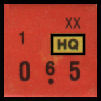
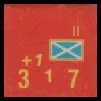
One comment